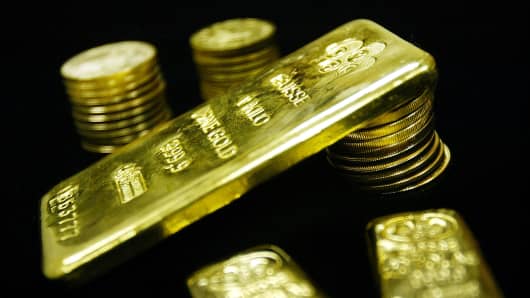 Gold
has gotten little love this year. With a 1.25 percent drop on Monday,
the precious metal has sacrificed what little gains it had in 2015. And
it could soon get even worse for bullion.
Gold
has gotten little love this year. With a 1.25 percent drop on Monday,
the precious metal has sacrificed what little gains it had in 2015. And
it could soon get even worse for bullion. That's because the Federal Reserve is finally expected to raise its key federal funds rate this year, perhaps as early as June. That could prove to be a highly deleterious event for gold, for several distinct but related reasons.
First, as short-term rates rise, holding gold becomes more painful. Gold is a not-yield-bearing asset, a fact that hardly matters in a world in which dollars are hardly a yield-bearing asset, either. But as the risk-free rate increases, keeping dollars stashed in safe accounts becomes relatively more attractive, compared to hoarding gold.
Second, as rates rise, more people around the world will look to keep their money stashed in greenbacks. The increased interest will cause the dollar itself to rise in value—making the price of gold relatively more expensive for overseas buyers, as Erin Gibbs of S&P Capital IQ points out.
"Since about 60 percent of all buyers of gold are from the
Asia/Pacific region, most of the buyers are buying it not in local currencies, but in terms of U.S. dollars," she said. "So as we see this continued dollar appreciation, that makes gold expensive for foreign buyers," tamping down on demand.
Finally, Fed tightening may finally shake out the true
gold believers who believed that the Fed's policies would lead to
massive inflation (which would, in turn, make gold a safer long-term
investment than cash or bonds). Quantitative easing
did not spur this inflation, and even as the American economy continues
to grow, inflation has actually remained below the Fed's 2 percent
target. Once the Fed tightens monetary policy, the inflation dreams may
finally die.
According to technician Todd Gordon, the future for gold looks bleak indeed.
"When the dollar really does break [higher], perhaps when the Fed raises rates, that will be the thing that finally pushes gold through the downside," Gordon said. "And for traders, gold is a great trader to the downside. It tends to be very deliberate, very tradable."
Read MoreWhere to hide out this earnings season
According to technician Todd Gordon, the future for gold looks bleak indeed.
"When the dollar really does break [higher], perhaps when the Fed raises rates, that will be the thing that finally pushes gold through the downside," Gordon said. "And for traders, gold is a great trader to the downside. It tends to be very deliberate, very tradable."
Read MoreWhere to hide out this earnings season
Phillip Streible, senior market strategist with RJO Futures, told CNBC that "gold may be down, but it is not out," arguing that a potential Greek exit from the euro zone, ongoing geopolitical shakiness in the Middle East and "frankly, the unknown future" are reasons why he would consider adding gold to a portfolio.
Of course, that same unknown future might also prove to be quite bearish for gold prices.

No comments:
Post a Comment